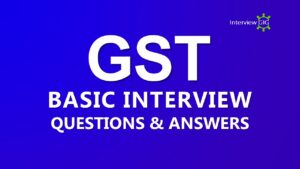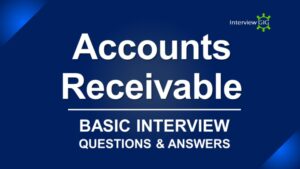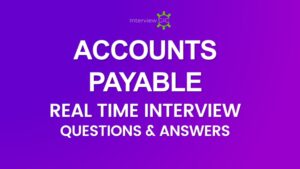Preparing for an interview in Anti-Money Laundering (AML), compliance, or financial crime roles requires a solid understanding of regulatory frameworks, risk assessment, and investigative procedures. These positions play a critical role in safeguarding financial institutions from illicit activities such as money laundering and terrorist financing. Interviewers typically focus on your knowledge of AML regulations, your ability to identify suspicious transactions, and how you apply compliance measures in real-world scenarios.
This blog covers essential AML interview questions and answers, including situational examples and expert tips, to help you confidently navigate your upcoming interview and demonstrate your expertise in this vital field.
Question: What is your understanding of Anti-Money Laundering (AML)? Do you have any prior experience working in AML-related roles?
Tip: A strong AML framework helps detect and prevent illicit financial activities, protecting both institutions and the economy.
Sample Answer:
Anti-Money Laundering (AML) refers to the regulations and practices designed to detect, prevent, and report financial crimes where illicit funds are disguised as legitimate income. While I haven’t worked directly in an AML-specific role, I am familiar with AML frameworks, compliance procedures, and financial crime prevention strategies.
Question: Why is AML important in financial institutions?
Tip: Highlight the significance of AML in protecting the financial system.
Sample Answer:
“AML is crucial for financial institutions as it helps prevent the misuse of the financial system for illegal activities, such as drug trafficking and fraud. By implementing robust AML measures, institutions protect themselves from legal penalties, safeguard their reputation, and contribute to the overall stability of the financial system. Additionally, effective AML practices help build trust with customers and regulators.”
Question: What are the key stages of money laundering?
Tip: Monitoring unusual transactions early can prevent successful laundering.
Sample Answer:
- Placement – Introducing illicit funds into the financial system (e.g., cash deposits).
- Layering – Concealing the origin of funds through multiple transactions.
- Integration – Legitimately reintroducing the laundered money into the economy.
Question: What are the main types of money laundering techniques you are familiar with?
There are many different money laundering techniques, but some of the most common include:
- Structuring: This involves breaking up large sums of money into smaller amounts to avoid detection.
- Smurfing: This is similar to structuring, but involves using multiple people to make the deposits.
- Shell companies: These are companies that exist only on paper and are used to disguise the movement of money.
- Trade-based money laundering: This involves over- or under-invoicing goods and services to move money across borders.
- Cryptocurrency: Cryptocurrencies can be used to launder money because they offer a high degree of anonymity.
Question: What is the difference between money laundering and terrorist financing?
Tip: Clearly differentiate between the two concepts.
Sample Answer:
“Money laundering focuses on concealing the origins of illegally obtained funds to make them appear legitimate, typically stemming from criminal activities. In contrast, terrorist financing involves providing financial support for terrorist activities, which can originate from both legal and illegal sources. The primary goal of money laundering is to disguise the money’s origin, while terrorist financing aims to fund operations, regardless of the source of the funds.”
Question: What is the difference between structuring and layering in money laundering?
Tip: Always follow the organization’s escalation process and ensure thorough documentation.
Sample Answer:
In a previous role, I noticed a client making frequent deposits just below the reporting threshold and transferring funds to multiple offshore accounts. I documented the transactions, escalated my concerns to the compliance team, and assisted in filing a Suspicious Activity Report (SAR).
Question: Describe a time when you identified suspicious activity. What steps did you take?
Tip: Focus on action and outcome.
Sample Answer:
“Once, I noticed a client making five $9,500 deposits in a week—just under the reporting threshold. It felt off. I dug into their profile and saw they ran a small café, which didn’t justify that volume of cash. I flagged it to our compliance team, froze the account temporarily, and filed a SAR. Later, it turned out the funds were linked to illegal gambling. Trusting my gut and following procedure paid off.”
Question: How do you assess the risk profile of a client or transaction?
Tip: Use a risk-based approach and monitor unusual transaction behaviors.
Sample Answer:
I assess risk by considering factors such as the client’s industry, transaction patterns, geographic location, and source of funds. High-risk clients often involve politically exposed persons (PEPs), high-cash businesses, or transactions linked to high-risk jurisdictions.
Question: How do you handle false positives in transaction monitoring?
Tip: Effective threshold tuning minimizes false positives and enhances detection efficiency.
Sample Answer:
I review flagged transactions by verifying customer history, transaction purpose, and supporting documents. If a false positive is identified, I document my findings and adjust monitoring thresholds or refine detection models to reduce unnecessary alerts.
Question: What is a Suspicious Activity Report (SAR), and when should it be filed?
Tip: Simplify the legal jargon.
Sample Answer:
A SAR is a confidential report submitted to regulatory authorities when a transaction appears suspicious or inconsistent with a customer’s normal activity. It should be filed when there is reasonable suspicion of fraud, money laundering, or other illicit activities.
Question: What is the role of regulatory bodies in AML compliance?
Tip: Focus on their key functions: setting rules, oversight, and enforcement.
Sample Answer: Regulatory bodies play a crucial role in AML compliance by establishing the legal framework, including laws and regulations that financial institutions must follow. They provide oversight, monitoring compliance through audits and examinations, and enforce these regulations by imposing penalties for violations. Examples include the Financial Action Task Force (FATF) globally, and specific country regulators like FinCEN in the US or the FCA in the UK. They also often provide guidance and best practices
Question: How do you assess and manage AML risk in an international banking environment?
Tip: Use automated screening tools and enhanced due diligence for high-risk clients.
Sample Answer:
I assess AML risk in international banking by evaluating cross-border transactions, high-risk jurisdictions, and customer profiles. I implement risk-based monitoring, screen for sanctions, and ensure compliance with international AML laws like FATF and OFAC regulations.
Question: What are some common AML red flags in transactions?
Tip: Monitor inconsistent transaction patterns and unexplained large fund transfers.
Sample Answer:
Common red flags include structured transactions, rapid fund movements across multiple accounts, and dealings with high-risk countries. Monitoring these patterns helps identify potential money laundering activities.
Common AML Red Flags in Transactions
- Frequent high-value cash deposits/withdrawals
- Unusual cross-border transactions
- Transactions just below reporting thresholds
- Lack of a clear business purpose for transactions
- Use of multiple accounts for structuring
Question: What is the difference between Customer Due Diligence (CDD) and Enhanced Due Diligence (EDD)?
Tip:
Clearly define each and explain when EDD is required.
Sample Answer: Customer Due Diligence (CDD) is the standard process of verifying the identity of customers and assessing their risk profile. It’s a foundational AML requirement. Enhanced Due Diligence (EDD) is applied when a customer presents a higher level of risk, such as politically exposed persons (PEPs), customers from high-risk countries, or those involved in high-risk industries. EDD involves more in-depth scrutiny and investigation to mitigate the increased risk, including enhanced monitoring and more frequent reviews.
Question: What is the role of OFAC in AML compliance, and how do you ensure compliance with OFAC regulations?
Tip: Explain OFAC’s focus on sanctions and how it ties into AML.
Sample Answer: The Office of Foreign Assets Control (OFAC) administers and enforces economic and trade sanctions against targeted countries, individuals, entities, and groups.
OFAC regulations are critical to AML compliance because sanctioned parties are often involved in money laundering and other illicit activities. To ensure compliance, we screen all customers and transactions against OFAC’s sanctions lists. We block or freeze assets of designated parties and report any blocked transactions to OFAC. Regular training for employees on OFAC regulations is also essential
Question: Can you explain the concept of Politically Exposed Persons (PEPs) and how they are treated in AML processes?
Tip: Link PEPs to real-world risks (e.g., corruption).
Sample Answer:
“PEPs are individuals in prominent public roles—like politicians or senior government officials—who might be more prone to bribery or corruption due to their position. In AML, we treat them as high-risk clients. For example, if a foreign minister opens an account, we’d do Enhanced Due Diligence: verifying their wealth sources, monitoring transactions closely, and getting senior management approval. It’s about mitigating the risk that their funds could be illicit.”
Question: Describe your experience with regulatory examinations or audits related to AML compliance.
Tip: Focus on collaboration and lessons learned.
Sample Answer:
“I’ve worked through two regulatory audits. For one, the regulator reviewed our SAR filings and transaction records. I prepared by organizing documentation, like KYC files and training logs, and explaining our risk assessment process. The audit highlighted gaps in our vendor due diligence, so we added stricter checks. It taught me that audits aren’t just about compliance—they’re opportunities to strengthen our systems.”
Question: Explain the FATF recommendations and their significance in global AML compliance.
Tip: Simplify FATF’s role as a global “rulebook.”
Sample Answer:
“The FATF’s 40 Recommendations are like the gold standard for fighting money laundering worldwide. They guide countries on things like customer due diligence, reporting suspicious activity, and freezing terrorist assets. Their ‘grey list’ and ‘black list’ shame non-compliant nations, pushing them to tighten laws. For banks, this means aligning policies with FATF to avoid fines or losing international partners.”
Question: Explain the role of transaction monitoring systems in detecting suspicious patterns. Which tools have you used (e.g., Actimize, LexisNexis)?
Tip: Name tools you’ve used and how they helped.
Sample Answer:
“These systems are the detectives of AML—they scan millions of transactions for odd patterns, like sudden spikes in activity or payments to sanctioned countries. At my last job, we used Actimize to set custom alerts, like flagging cash deposits over $10k in rural branches. It reduced false positives by 20% with its machine learning. I’ve also used LexisNexis for screening high-risk clients against global watchlists.”
Question: What steps would you take if a customer’s transaction triggers a sanctions list hit during screening?
Tip: Emphasize immediate action and due diligence.
Sample Answer: If a customer’s transaction triggers a sanctions list hit, the first step is to immediately freeze the transaction.
We then need to verify the hit to ensure it’s not a false positive. This involves carefully comparing the customer’s information against the details on the sanctions list, paying close attention to names, addresses, and other identifying factors. If it’s a confirmed hit, we must report the blocked transaction to the relevant authorities, such as OFAC in the US, and follow their guidance on further action. We also need to review the customer’s overall relationship with the institution and determine if further investigation or account closure is necessary.
Question: Can you provide an example of a complex AML case you worked on and the outcome?
Tip: Collaboration with law enforcement and regulatory bodies is crucial for complex AML cases.
Sample Answer:
In a past case, a corporate client was flagged for frequent large transactions with a high-risk jurisdiction. Investigation revealed shell companies linked to illicit activities. We escalated the case, conducted Enhanced Due Diligence (EDD), and reported it via a Suspicious Activity Report (SAR). Authorities later confirmed the client was involved in a money-laundering network.
Question: How do you stay updated on evolving AML risks, such as cryptocurrency-related threats?
Tip: Highlight continuous learning and diverse sources.
Sample Answer: Staying current on AML risks, especially with rapidly evolving areas like cryptocurrency, requires continuous learning. I regularly review publications from regulatory bodies like FATF and FinCEN, as well as industry news and reports from organizations specializing in financial crime. I also follow developments in technology and attend webinars and conferences to stay informed about emerging threats and best practices in AML compliance.
Question: Explain the “Three Lines of Defense” model in AML compliance.
Tip:Clearly define each line and its responsibilities.
Sample Answer: The “Three Lines of Defense” model is a framework for managing risk, including AML risk. The first line of defense is operational management, which includes business units that directly interact with customers and are responsible for implementing AML controls. The second line of defense is the compliance function, which develops AML policies, provides training, and monitors the effectiveness of controls. The third line of defense is internal audit, which provides independent assurance to the board and senior management on the adequacy and effectiveness of the AML program.
Question: How do you identify and screen transactions against sanctions lists like OFAC? Describe your experience with sanction screening tools.
Tip: Regularly update sanctions screening databases to avoid missing new listings.
Sample Answer:
Use automated tools (e.g., World-Check, Actimize, LexisNexis) to screen against OFAC, EU, and UN sanctions lists.
Review flagged transactions for false positives.
Apply real-time transaction monitoring to detect high-risk transactions.
Escalate confirmed matches and ensure regulatory reporting. I have used sanction screening tools like Actimize and LexisNexis to monitor transactions against OFAC and other watchlists. When a match occurs, I conduct due diligence, escalate cases, and report to authorities as required.
Scenario: A customer suddenly starts making large cash deposits into their account, far exceeding their usual activity. How would you handle this?
Focus: Suspicious activity monitoring, customer due diligence.
Sample Answer:
I would first analyze the customer’s historical transaction patterns to determine if these large cash deposits are unusual. If the activity deviates significantly, I would contact the customer for clarification and request supporting documentation on the source of funds. If the explanation is unsatisfactory or inconsistent, I would escalate the case to compliance and potentially file a Suspicious Activity Report (SAR) as per regulatory guidelines.
Scenario: A customer opens an account using a foreign passport and provides limited information about their business. What are your concerns?
Focus: KYC/CDD, risk assessment.
Sample Answer: Given that the customer has provided limited business details, I would assess the risk level based on the jurisdiction of the passport (e.g., high-risk country as per FATF lists) and conduct KYC checks to validate their identity. I would request additional documentation, such as business registration certificates, financial statements, and proof of address. If the customer is reluctant to provide sufficient information, I would flag the account for closer monitoring and escalate for further review.
Scenario: You notice a transaction involving a country on the sanctions list. What steps do you take? • Focus: Sanctions compliance.
As soon as I notice the transaction, I would:
- Pause the Transaction – Prevent processing until further verification.
- Screen the Entities – Cross-check all involved parties against sanctions lists.
- Notify Compliance – Escalate the issue for a formal review.
- Document and Report – Record all findings and prepare a Suspicious Activity Report (SAR) if necessary.
If the transaction is deemed a violation, I would ensure it is not processed and comply with all reporting obligations.
Scenario: A customer frequently sends and receives wires to/from high-risk jurisdictions. How do you assess the risk?
Focus: Risk assessment, transaction monitoring.
Sample Answer :
I would conduct a risk-based analysis by assessing:
- The jurisdiction risk (e.g., FATF high-risk or OFAC-sanctioned countries).
- The nature of the customer’s business to determine if such transactions align with their profile.
- The volume and frequency of the transactions to detect anomalies.
If suspicious patterns emerge, I would escalate for Enhanced Due Diligence (EDD), request additional documentation, and report the activity if necessary.
Scenario: You suspect a colleague is involved in money laundering. What do you do?
Focus: Ethical considerations, internal reporting.
Sample Answer: “If I suspect that a colleague is involved in money laundering, my first step would be to adhere to the ethical standards and internal policies of our organization. I would promptly report my suspicions to my supervisor or the compliance department, following the company’s whistleblower policy to ensure that my concerns are addressed appropriately and confidentially. It’s crucial to act swiftly and responsibly in such situations to protect the integrity of our organization and comply with legal obligations. I would also document any relevant observations or evidence to support my report, ensuring that I provide as much information as possible for the investigation.”
Scenario: You identify a pattern of structuring (small deposits made to avoid reporting thresholds). How do you proceed?
Focus: Suspicious activity monitoring, AML regulations.
Sample Answer :
Upon detecting structuring (small, frequent deposits to avoid reporting thresholds), I would:
- Analyze Transaction Trends – Confirm the pattern aligns with potential structuring tactics.
- Review Customer Profile – Determine if the activity is consistent with their financial behavior.
- Escalate to Compliance – Report findings for further review.
- Assist in Filing a SAR – If required, document the details in a Suspicious Activity Report (SAR) to regulatory authorities.
Scenario: A customer’s behavior changes dramatically after a large deposit. They become nervous and evasive. What’s your next step?
Focus: Recognizing red flags, customer interaction.
Sample Answer:
A sudden change in behavior after a large deposit is a red flag for potential money laundering. I would:
- Maintain Professionalism & Observe Closely – Without alarming the customer.
- Ask Open-Ended Questions – To understand the source of funds.
- Verify Supporting Documents – If explanations seem inconsistent.
- Report to Compliance – If red flags persist, I would escalate for further investigation.
Scenario: You discover a discrepancy in a customer’s stated income and their transaction activity. How do you reconcile this?
Focus: Customer due diligence, information verification.
Unexplained discrepancies in income vs. transaction activity could indicate fraud, money laundering, or undisclosed income sources. I would:
- Conduct a Risk-Based Review – Cross-check past deposits and withdrawals.
- Request Additional Documentation – To justify the unusual activity.
- Assess Potential Red Flags – Look for links to high-risk industries or jurisdictions.
- Report to AML Compliance – If the explanation remains unclear, I would escalate for further scrutiny.
Scenario: You notice a customer making frequent cryptocurrency transactions. What are your concerns? Focus: Understanding of virtual assets, emerging AML risks.
Sample Answer :
Frequent cryptocurrency transactions raise concerns due to their anonymity, high volatility, and potential misuse for illicit activities. I would:
- Review the Customer’s Profile & Business Activity – Determine if crypto trading aligns with their risk profile.
- Assess Transaction Patterns – Look for irregular spikes or transactions with high-risk exchanges.
- Conduct Enhanced Due Diligence (EDD) – Request source of funds, purpose, and counterparties involved.
- Escalate if Needed – If transactions seem suspicious or involve unregulated platforms, I would report to compliance.
Scenario: You’re unsure about whether a particular transaction is suspicious. What do you do?
Focus: Professional judgment, escalation procedures.
Sample Answer: “If I find myself unsure about whether a particular transaction is suspicious, I believe it’s crucial to err on the side of caution. I would document my observations and concerns regarding the transaction and then consult with my supervisor or compliance officer for guidance. Engaging in open communication with my team is essential, as they may have additional insights or information that could clarify the situation. By following the escalation procedures, we can ensure that any potential risks are thoroughly evaluated and addressed appropriately, maintaining the integrity of our operations and compliance with regulatory requirements.”
Excelling in an AML or financial crime interview means showcasing not only your technical knowledge of regulations and compliance programs but also your practical experience in detecting and managing risks. By preparing clear, example-driven answers to common and situational questions, you can demonstrate your analytical skills, attention to detail, and commitment to upholding financial integrity. Whether you are a fresher or an experienced professional, thorough preparation will empower you to impress your interviewers and secure a role where you contribute meaningfully to combating financial crime and protecting the financial system.




